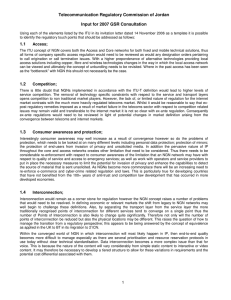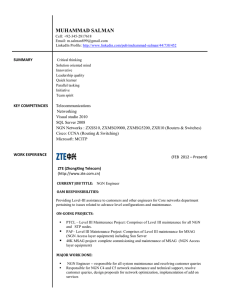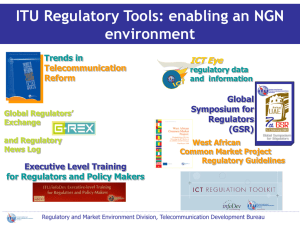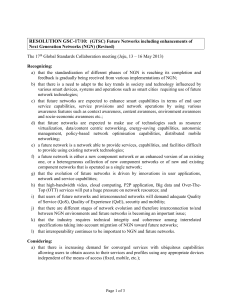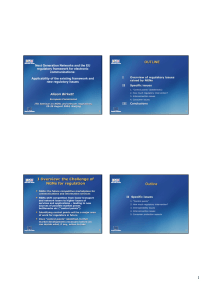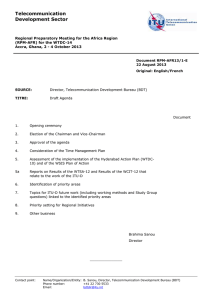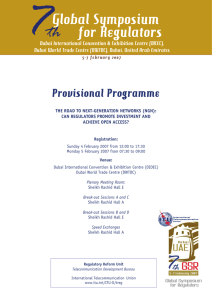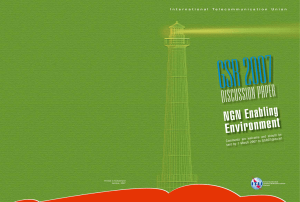Question 26/2 – Migration from existing networks to next-generation networks
advertisement
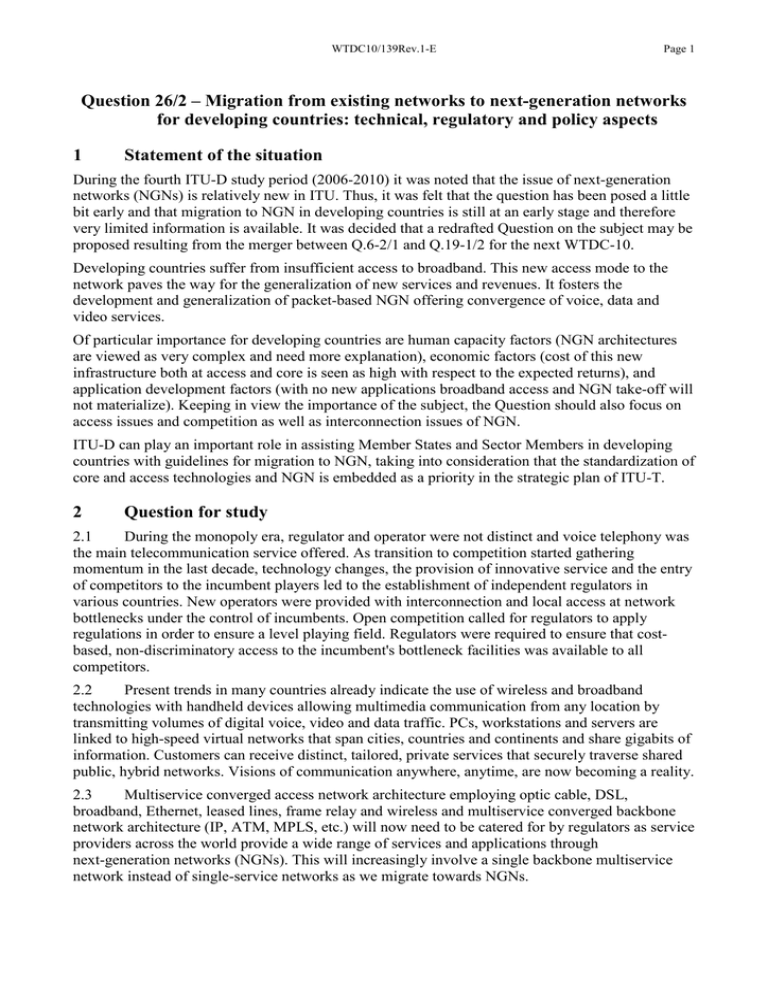
WTDC10/139Rev.1-E Page 1 Question 26/2 – Migration from existing networks to next-generation networks for developing countries: technical, regulatory and policy aspects 1 Statement of the situation During the fourth ITU-D study period (2006-2010) it was noted that the issue of next-generation networks (NGNs) is relatively new in ITU. Thus, it was felt that the question has been posed a little bit early and that migration to NGN in developing countries is still at an early stage and therefore very limited information is available. It was decided that a redrafted Question on the subject may be proposed resulting from the merger between Q.6-2/1 and Q.19-1/2 for the next WTDC-10. Developing countries suffer from insufficient access to broadband. This new access mode to the network paves the way for the generalization of new services and revenues. It fosters the development and generalization of packet-based NGN offering convergence of voice, data and video services. Of particular importance for developing countries are human capacity factors (NGN architectures are viewed as very complex and need more explanation), economic factors (cost of this new infrastructure both at access and core is seen as high with respect to the expected returns), and application development factors (with no new applications broadband access and NGN take-off will not materialize). Keeping in view the importance of the subject, the Question should also focus on access issues and competition as well as interconnection issues of NGN. ITU-D can play an important role in assisting Member States and Sector Members in developing countries with guidelines for migration to NGN, taking into consideration that the standardization of core and access technologies and NGN is embedded as a priority in the strategic plan of ITU-T. 2 Question for study 2.1 During the monopoly era, regulator and operator were not distinct and voice telephony was the main telecommunication service offered. As transition to competition started gathering momentum in the last decade, technology changes, the provision of innovative service and the entry of competitors to the incumbent players led to the establishment of independent regulators in various countries. New operators were provided with interconnection and local access at network bottlenecks under the control of incumbents. Open competition called for regulators to apply regulations in order to ensure a level playing field. Regulators were required to ensure that costbased, non-discriminatory access to the incumbent's bottleneck facilities was available to all competitors. 2.2 Present trends in many countries already indicate the use of wireless and broadband technologies with handheld devices allowing multimedia communication from any location by transmitting volumes of digital voice, video and data traffic. PCs, workstations and servers are linked to high-speed virtual networks that span cities, countries and continents and share gigabits of information. Customers can receive distinct, tailored, private services that securely traverse shared public, hybrid networks. Visions of communication anywhere, anytime, are now becoming a reality. 2.3 Multiservice converged access network architecture employing optic cable, DSL, broadband, Ethernet, leased lines, frame relay and wireless and multiservice converged backbone network architecture (IP, ATM, MPLS, etc.) will now need to be catered for by regulators as service providers across the world provide a wide range of services and applications through next-generation networks (NGNs). This will increasingly involve a single backbone multiservice network instead of single-service networks as we migrate towards NGNs. WTDC10/139Rev.1-E Page 2 2.4 In existing, conventional networks in most countries, regulatory control is confined to interconnections and other bottleneck access and core network issues. These are readily identifiable, and the consequences are fairly predictable if competitive activity is left unchecked. In NGNs, however, points calling for regulatory control will not be easy to identify as they may reside in any layer of network hierarchy, i.e. from basic access to services or even content. It will be excessively difficult to predict the regulatory impact of the introduction of NGNs. 2.5 NGN today may divide the historical operators in three types of operators a) service providers, b) operators for transmission of packets, and c) operators for management of NGN system, responsible for the quality of service and for the accounting issues. The NGN is supposed to provide all kind of ITC and telecommunication services at any moment and anywhere at the best possible price. At present, the only country which started to implement NGN networks on a large scale is the United Kingdom. NGNs cover both wired and wireless telecommunications, but it is wide-band. It is basically using soft switches everywhere. 2.6 Effective study needs sufficient examination of NGN technologies and insight into deployments of broadband access and NGN core technologies, what it really does and what are the principles and methodologies for migration planning, taking into account in particular existing networks to evolution of core network into NGN. It also requires the migration plans of various operators specially incumbent. In case of NGN, interconnection is required at transport and service layer. Therefore to understand regulatory impact of next-generation networks on interconnection the issues related to network (like change in number and location of interconnection points, which services should be regulated overall framework for wholesale billing, etc.) are to be considered as part of this question. 2.7 Methodologies for migration planning, taking into account in particular existing networks to evolution of core network into NGN. 3 Expected output 3.1 In the next ITU-D study period 2010-2014, studies of various issues related to migration from existing networks to next-generation networks are to be reported, and among others the description of the technical, legislative and regulatory framework that would be needed to implement appropriate interconnection arrangements for new generation networks. Economic impact to implement these interconnection arrangements are also to be reported. 4 Timing 4.1 Mid-term report is expected by 2011. 4.2 Final report is expected by 2013. 5 Proposers There was consensus at the WTDC-10, held in Hyderabad, that the issue of the migration from existing networks to next-generation networks is of extreme importance to all countries, particularly developing countries, and needs to be continued as a revised Question in the next study period 2010-2014 with a view to highlighting the impact of NGNs on this issue. 6 Sources of input The major source of input will be the experiences of those countries that have introduced competition and addressed the question of interconnection. Contributions from Member States and Sector Members will be essential to the successful study of the issue. Interviews, existing reports WTDC10/139Rev.1-E Page 3 and surveys should also be used to gather data and information for finalization of a comprehensive set of best practice guidelines for administering interconnection for NGNs. Material from regional telecommunication organizations, telecommunication research centres and manufacturers and working groups should also be utilized in order to avoid duplication of work. Close cooperation with ITU-T study groups, in particular SG 13 and the Global Standards Initiative (GSI) for NGN and other standards groups involved in NGN activities and other activities within ITU-D is required and extremely important. 7 Target audience Target audience a) Developing countries1 Developed countries Telecommunication policy-makers Interested. Highly interested because of lack of experience. Telecommunication regulators Interested and experienced with different models. Highly interested. Some countries have immediate need for information. Service providers/operators New entrants, regardless of size, extremely interested. New entrants, regardless of size, extremely interested. Manufacturers Highly interested. It will promote infrastructure development. Highly interested. It will promote infrastructure development. Target audience Based on the foregoing evaluation matrix, a broad range of telecommunication policy-makers, regulators and service providers from least developed countries and developing countries will all be highly interested in the results of the Question. Policy-makers and regulators from developed countries will also be interested in many of the issues addressed. Manufacturers will also have a high interest in the Question since appropriate interconnection measures will promote infrastructure development. b) Proposed methods for the implementation of the results The output of the study (report and guidelines) would be distributed as the output results of the ITU-D study groups. Given the importance of the issue, however, BDT could also conduct regional seminars and meetings, perhaps in conjunction with regional telecommunication organizations, to disseminate the results of the study on the Question. The results should be transmitted to the ITU-D Global Symposium for Regulators held annually, when the theme relates to interconnection. The results should be published by ITU for wider distribution. 8 Proposed methods of handling the Question Within Study Group 2. ____________________ 1 This includes least developed countries (LDCs), small island developing states (SIDS), landlocked developing countries (LLDCs) and countries with economies in transition. WTDC10/139Rev.1-E 9 Page 4 Coordination 9.1 Because the issue of interconnection and access is related to other issues being studied by ITU, coordination will be required not only within the ITU-D study groups and programmes but also with the study groups of the other ITU Sectors. 9.2 Regional organizations (such as CITEL, ATU and APT) would also require to be involved so that issues related to interconnection and access are coordinated and duplication of efforts minimized. 10 Other relevant information As may become apparent within the life of this Question. ______________
